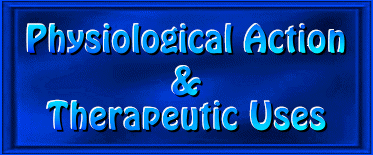

The following is excerpted from The Professional's Herbal Formula Handbook No. 2, comprising 82 pages of traditional information and recent scientific data that describes the medical properties, physiological action and therapeutic uses for each of the 24 ingredients outlined in this formula.




Adaptogenic, alterative, anabolic, anti-aggregant, antibiotic, anti-cachexic, anti-dyscratic, anti-infective, antioxidant, antiphlogistic (anti-inflammatory), antiseptic, bacteriostatic (anti-bacterial), cytophylactic, cytotoxic, disinfectant, immuno-potentiating, immuno-stimulant, microbicidal (anti-microbial), rejuvenative, restorative, stimulant (circulatory and secretolytic), tonic, vasodilator and viricidal (anti-viral).


Alleviates any general fluids dyscrasia (abnormal or pathological condition) within the blood vessels or tissue-systems throughout the entire organism that leads to the onset of various forms of immuno-depressant or immuno-suppressant conditions, and eliminates any form of cachexia (state of malnourishment and general debility) within the blood vessels, tissue-systems or mucous membranes throughout the entire organism in order to provide increased protection against any nutritional deficiencies or insufficiency that leads to various forms of immuno-depression or immuno-suppression; exhibits immuno-potentiating and immuno-stimulatory effects in order to enhance greater long-term immune potential and overall non-specific systemic immunity (or immune cell activity) and increased immune response (by activating the body's natural defense mechanisms), particularly in relation to the repair and restoration of any damaged or congested blood vessels, tissue-systems or mucous membranes throughout the entire organism; reduces those symptoms associated with any common allergic or immune-related disorders, such as asthma, cirrhosis of the liver, psoriasis (and other eruptive skin disorders) and cardiovascular disease (including strokes and abnormal blood-clotting conditions); displays powerful adaptogenic (balancing and strengthening) activity in order to increase the overall resistance of an organism towards any adverse influences or stressful conditions (whether they be physical, chemical or biological in nature), especially upon the immune system and both the central (cerebro-spinal centers) and peripheral nervous systems; exhibits adaptogenic properties in order the enhance the body's ability to better adapt to any internal toxic stress by strengthening the functional capabilities of the glandular, immune and nervous systems, and protects against any tissue or organ damage from certain environmental toxins (such as herbicides and pesticides); inhibits any systemic organ damage from potentially dangerous chemicals known as "free radicals", and acts as a powerful antioxidant for the neutralization and removal of any excess free radicals throughout the entire organism; prevents any cellular damage from excessive free radicals that are generated during chronic activation of the immune system, and exerts profound general tissue effects that include membrane-stabilizing, antioxidant and free-radical scavenging activity (especially throughout the central nervous system); stabilizes the cellular membranes (which are fluid barriers or defense mechanisms against any form of cellular invasion), and enhances greater metabolic, rheological, vascular and immunological functions; acts as an extremely effective inhibitor of any lipid peroxidation in various cellular membranes that is directly induced by oxygenated free radicals, and provides greater tonicity to the vein that is essential to the dynamic elimination of various toxic metabolites that accumulate during any lowered oxygen levels; alleviates any intermittent claudications (painful leg cramps) associated with arterial insufficiency (reduction of blood flow to a specific area) that leads to hypoxia (oxygenation deficiencies), which increases the production of toxic metabolites and cellular free radicals; prevents the formation of any metabolic or neuronal disturbances associated with hypoxia by enhancing the utilization of oxygen and increasing the cellular absorption of glucose, thereby restoring aerobic glycolysis; possesses certain compounds (terpenes) that inhibit the platelet activating factor (PAF-acether) from activating various immune cells (neutrophils, eosinophils, macrophages and other phospholipids) and endothelial cells, which can over-stimulate the immune system and lead to conditions involving toxic shock from bacterial sepsis (poisoning); displays potent inhibitory effects against the platelet activating factor (known as ginkgolide B>A>C) by competing with PAF-acether for binding (receptor) sites, and significantly reduces platelet aggregation by stabilizing the platelet's membranes and scavenging any damaging free radicals; re-establishes effective tissue perfusion, and increases the perfusion rate to various areas of the vascular system (e.g., arterial, arteriolar, microcirculatory, venular and venous components); improves the quality and quantity of the microcirculation in order to increase circulatory flows to all the vital tissues and organs, and displays vasodilator activity by directly stimulating the release of endothelium-derived relaxing factor (EDRF) and prostacyclin; stimulates the synthesis of prostacyclin, which is the natural anti-aggretory prostaglandin that is synthesized by the vascular endothelium (the cells that line the inside of the blood vessel); prevents any free-radical damage to the myelin insulating sheath that surrounds the nerve, brain cells and all the cells and organs throughout the entire organism, due to the presence of (1) heteroside flavonoids (quercetin, kaempferol and isorhamnetin), (2) coumarin esters of quercetin, kaempferol and glucorhamnoside, (3) proanthocyanidins (ionized flavonoids), and (4) catechins; protects against any nerve degeneration, while preserving the functional capabilities of the neurotransmitters throughout the entire organism; stimulates the release of various chemical neurotransmitters known as "catecholamines" (epinephrine and norepinephrine), thereby improving the functional capabilities of the entire network of catecholaminergic glandular, cardiovascular and nervous systems throughout the body; promotes increased nerve transmission, and stabilizes the lysosomal membranes; activates the membranal enzyme Na + K + ATP - ase (or sodium pump) that is responsible for the exchange of intracellular sodium for extracellular potassium, thereby improving the process of membranal polarization (which is extremely important in excitable tissues such as the muscles and nerves); improves the overall membranal dynamics (including the correction of any ionic membranes), and enhances greater cellular energy production by beneficially affecting the various intracellular components; improves both blood and plasma viscosity, and exhibits a direct effect upon endothelial cells in order to enhance greater blood flows in both the arteries and veins without any alteration in systemic blood pressure; exhibits vascular effects, thereby directly affecting and enhancing the tonicity of the smooth muscle cells that line the walls of the blood vessels; exhibits anabolic activity in order to accelerate the production of DNA and RNA (which enhances the production of proteins in the form of antibodies), while increasing protein and lipid synthesis in the bone marrow and DNA and RNA content in the adrenals and lymph nodes (along with increased body weight and enhanced re-synthesis of glycogen and high-energy phosphate compounds); displays cytophylactic and cytotoxic properties in order to provide stronger cellular defense mechanisms against many physical or chemical agents and infectious conditions, including various brain, skin or intestinal infections; exhibits bacteriostatic, microbicidal and viricidal activity in order to strengthen and increase the resistance of the blood vessels against any invasive or harmful pathogenic bacteria or microbes, as well as to inhibit the further development of any inflammatory or infectious conditions associated with various auto-immune disorders; displays significant antiphlogistic activity in order to inhibit the formation of certain inflammatory compounds (such as histamine, leukotrienes, prostaglandin, serine proteases and thromboxanes), as well as to reduce any severe inflammatory swelling associated with various auto-immune system disorders by exerting an extremely positive influence towards correcting any blood vessel or tissue inflammation and various other internal inflammatory conditions; exhibits significant antiseptic activity by destroying the vitality of any organized living ferments in order to prevent the onset of putrefaction or septicemia, and precipitates the proteins in any inflamed tissues in order to provide a mildly antiseptic and protective coating (under which the regeneration of new tissue occurs) for the mucous membranes throughout the entire organism; acts as an effective antiseptic in order to remove any septic conditions associated with tissue degeneration or ulceration, and promotes increased suppuration and a steady toning or restorative impression to the entire glandular system (especially the liver and lymph glands); acts as a secretolytic stimulant in order to promote increased gastric, pancreatic or intestinal secretory and motor activity, and enhances greater peripheral circulation (due to its antioxidant activity); exhibits significant antioxidant effects in order to provide greater oxygen-transport capabilities throughout the bloodstream, as well as enhance the transport of additional oxygen directly into the cells and tissue-systems throughout the entire organism; acts as a circulatory stimulant by increasing the blood flows through the arteries and blood vessels in order to enhance greater nutrient transport, absorption and utilization, thereby accelerating the healing processes associated with the repair of any damaged mucous membranes or tissue-systems (while reducing any fevers or feverish states); demonstrates significant rejuvenative and restorative properties upon the basic plasma tissue-systems throughout the entire organism, thereby enhancing the production of vital bodily fluids while providing greater enrichment through increased assimilation of the various organic mineral salts; accelerates the recuperative processes that are essential in order to overcome any chronic debilitating or degenerative brain diseases or illnesses, while facilitating greater recovery response during convalescence in order to regain optimal health and well-being; displays alterative activity in order to correct any disordered bodily function, thereby activating increased alterations in both metabolic and tissue functions as a defensive measure against the onset of acute or chronic disease; exhibits restorative effects in order to regain increased vigor or vitality and greater strength, while enhancing normal tissue and metabolic functional capabilities; demonstrates alterative and restorative properties in order to re-establish healthy systemic functional capabilities, as well as to establish greater vascular tone throughout the entire organism (due to its ability to stimulate increased secretory flows); exhibits alterative effects in order to stimulate the anabolic growth processes, thereby enhancing the repair of any degenerated, deteriorated and debilitated cells or tissues (while promoting the elimination of any catabolic waste materials); displays tonifying effects in order to permanently enhance the overall energy-levels throughout the entire organism, without adversely affecting the functional capabilities of any particular organ or system.
![]()
None.
![]()